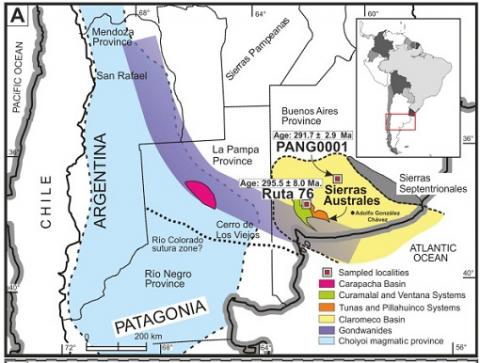Guadalupe Arzadún, Renata N. Tomezzoli, Ricardo Trindade, Leandro C. Gallo, Nora N. Cesaretti, Juan M. Calvagno
2 018
Journal of South American Earth Sciences Volume 85, August 2018, Pages 191-208
Pyroclastic levels are descripted in Sierras Australes outcrops and Claromeco Basin sub-surface records, interbedded with mudrocks and coal beds in the base of the Tunas Formation sequence that correspond to the Permian South West margin of Gondwana. The pyroclastic levels classify as fine tuff. SHRIMP zircon ages obtained are 291.7 ± 2.9 Ma in the outcrop and 295.5 ± 8.0 Ma in the subsurface. These ages are consistent with other zircon SHRIMP ages of other outcrops tuff of the Tunas Formation, with Permian flora, and with tuff ages of correlated Gondwana areas, in the Paraná, Karoo and Paganzo basins. These data, in addition with other geological evidences, support a tectonically active and changing environment during the Permian of Gondwana. The ages allowed calculating a northward latitudinal speed of 2.7 cm/year for Gondwana during the Permian. This latitudinal movement is explained as the consequence of the final coupling of several continental microplates, gradually amalgamated from the southern margins of Gondwana and from the northern of Laurentia to configure the final Pangea during the Triassic. Since the main accretions in the southwestern margin of Gondwana could have started during the Devonian - Carboniferous, this Permian orogeny (San Rafael Orogenic Phase in Argentina) would be representing the post - collisional deformation, with a peak of compression in the Early Permian that was attenuating towards the foreland during the Late Permian - Early Triassic. With these results, it is also possible to constraint the age of the upper Paleozoic glaciation up to 295, previous to the deposition of the Tunas Formation in the Sauce Grande Formation.
https://www.sciencedirect.com/science/article/pii/S0895981117304492#!

